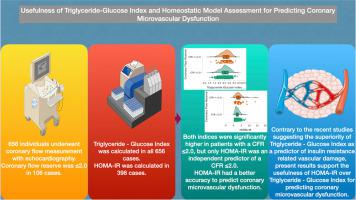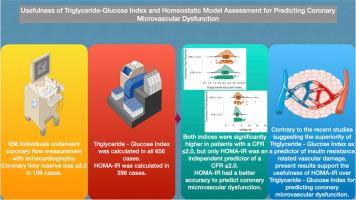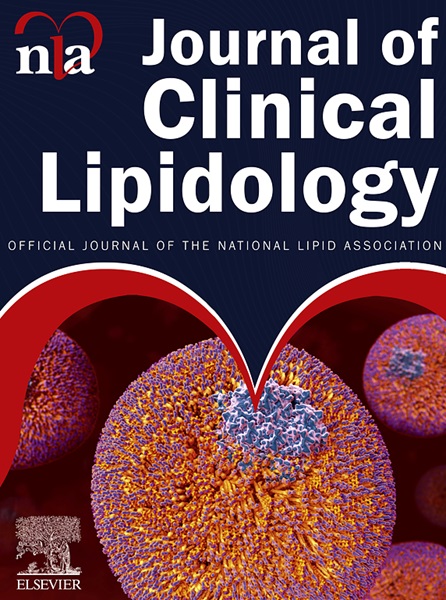甘油三酯-葡萄糖指数和稳态模型评估对预测冠状动脉微血管功能障碍的作用
IF 3.6
3区 医学
Q2 PHARMACOLOGY & PHARMACY
引用次数: 0
摘要
背景胰岛素抵抗(IR)患者常出现冠状动脉微血管功能障碍(CMD)。胰岛素抵抗的静态模型评估(HOMA-IR)是广泛使用的胰岛素抵抗替代标志物,但最近的研究表明甘油三酯-葡萄糖(TyG)指数是一种更好的胰岛素抵抗标志物,在预测 2 型糖尿病或心血管预后方面比 HOMA-IR 更准确。方法回顾性审查了所有纳入机构冠状动脉血流储备登记的病例,纳入了 656 例无心外膜冠状动脉疾病且无动脉粥样硬化主要危险因素的病例。结果所有病例均有 TyG 指数,398 例有 HOMA-IR 指数。在单变量分析中,TyG指数和HOMA-IR均与CMD相关,而在调整潜在混杂因素后,HOMA-IR(比值比[OR]:1.38,95%置信区间[CI]:1.14-1.67,P = 0.001)与CMD相关,但TyG指数(比值比[OR]:1.48,95%置信区间[CI]:0.82-2.67,P = 0.19)与CMD无关。HOMA-IR的预测准确性(c统计量:0.63,95% CI:0.54-0.72,p = 0.003)高于TyG指数(c统计量:0.55,95% CI:0.47-0.63,p = 0.13),但差异无统计学意义(DeLong p = 0.23)。有强有力的证据表明,HOMA-IR(BF10:3507)在 CMD 组与非 CMD 组之间存在真正的差异,但 TyG 指数(BF10:0.66)则不存在这种差异。本文章由计算机程序翻译,如有差异,请以英文原文为准。


Usefulness of triglyceride-glucose index and homeostatic model assessment for predicting coronary microvascular dysfunction
BACKGROUND
Coronary microvascular dysfunction (CMD) is a common occurrence in individuals with insulin resistance (IR). Homeostatic model assessment for insulin resistance (HOMA-IR) is a widely used surrogate marker of IR, although recent studies suggest triglyceride-glucose (TyG) index is a superior marker of IR that had a better accuracy to predict type 2 diabetes or cardiovascular outcomes than HOMA-IR.
OBJECTIVES
We aimed to assess the accuracy and usefulness of TyG index and HOMA-IR for predicting CMD as assessed with echocardiographic coronary flow reserve (CFR) measurement.
METHODS
All cases included in the institutional CFR registry were retrospectively reviewed, and 656 cases without epicardial coronary artery disease and without major risk factors for atherosclerosis were included. A CFR ≤2.0 was defined as CMD.
RESULTS
TyG index was available in all cases, while HOMA-IR was available in 398 cases. Both TyG index and HOMA-IR were associated with CMD on univariate analyses, while after adjustment for potential confounders HOMA-IR (odds ratio [OR]:1.38, 95% confidence interval [CI]:1.14–1.67, p = 0.001) but not TyG index (OR:1.48, 95% CI:0.82–2.67, p = 0.19) was associated with CMD. The predictive accuracy of HOMA-IR (c-statistic:0.63, 95% CI:0.54–0.72, p = 0.003) was higher than TyG index(c-statistic:0.55, 95% CI:0.47–0.63, p = 0.13), although the difference was not statistically significant (DeLong p = 0.23). There was strong evidence favoring a true difference between CMD vs. non-CMD groups for HOMA-IR (BF10:3507) but not for TyG index(BF10:0.66).
CONCLUSIONS
HOMA-IR, but not TyG index, is closely associated with CMD.
求助全文
通过发布文献求助,成功后即可免费获取论文全文。
去求助
来源期刊
CiteScore
7.00
自引率
6.80%
发文量
209
审稿时长
49 days
期刊介绍:
Because the scope of clinical lipidology is broad, the topics addressed by the Journal are equally diverse. Typical articles explore lipidology as it is practiced in the treatment setting, recent developments in pharmacological research, reports of treatment and trials, case studies, the impact of lifestyle modification, and similar academic material of interest to the practitioner.
Sections of Journal of clinical lipidology will address pioneering studies and the clinicians who conduct them, case studies, ethical standards and conduct, professional guidance such as ATP and NCEP, editorial commentary, letters from readers, National Lipid Association (NLA) news and upcoming event information, as well as abstracts from the NLA annual scientific sessions and the scientific forums held by its chapters, when appropriate.

 求助内容:
求助内容: 应助结果提醒方式:
应助结果提醒方式:


